中药现代化与国际化探索
中药现代化的主要内容

中药现代化是指将传统中药理论与现代科学技术相结合,通过现代化的研究方法和技术手段,对中药进行深入的研究和开发,以提高中药的质量、疗效和安全性,推动中药现代化、国际化和产业化。
中药现代化的主要内容包括以下几个方面:
1. 中药质量控制:中药现代化的前提是要保证中药的质量和安全性。
因此,中药现代化的第一步就是加强中药质量控制,采用现代化的检测技术和方法,对中药进行全面的质量检测和评价。
2. 中药现代化研究:中药现代化的核心是中药现代化研究,主要包括中药成分分析、药效评价、药物制剂研究等方面。
中药现代化研究需要运用现代科学技术和研究方法,如分离纯化技术、高效液相色谱技术、生物技术等,以深入研究中药的成分、药理作用和药效评价。
3. 中药制剂开发:中药现代化的另一个重要方面是中药制剂开发。
中药制剂开发需要结合现代制剂技术,对中药进行合理的配伍和制剂工艺研究,以开发出符合现代人需求的中药制剂,如口服液、胶囊、注射剂等。
4. 中药国际化:中药现代化的最终目的是推动中药的国际化。
中药现代化研究需要结合国际标准和规范,对中药进行标准化和规范化研究,以提高中药的国际认可度和市场竞争力。
总之,中药现代化是一个综合性的工程,需要各方面的专家和技术人员共同努力,以推动中药的现代化、国际化和产业化。
中药现代化与国际化的发展趋势

中药现代化与国际化的发展趋势一、背景中药是中国传统文化的重要组成部分,拥有悠久的历史和丰富的经验。
在过去的几千年里,中药被广泛运用于中国人的日常生活中,治疗各种疾病和保健养生。
然而,随着现代医学的发展和全球化的浪潮,中药的现代化与国际化趋势也日益凸显。
二、中药现代化的趋势1.科学研究与现代技术的应用随着科学技术的进步,越来越多的研究机构开始运用现代科学方法来研究中药的药理和功效。
诸如高通量筛选、分子生物学、生物信息学等新技术的应用,为中药现代化提供了新的思路和方法。
通过对中药成分的分析和提取,科学家们可以更好地了解中药的作用机制,为中药的开发和利用提供更科学的依据。
2.标准化生产与质量控制中药的标准化生产和质量控制是中药现代化的重要方面。
通过制定严格的生产工艺标准和质量控制标准,可以确保中药产品的安全性和有效性。
越来越多的中药生产企业开始引进国际标准,采用先进的生产工艺和设备,提高中药产品的质量和竞争力。
标准化生产也有助于中药产品面向国际市场,赢得国际认可。
3.中药疗效的临床验证中药的疗效一直备受争议,主要是由于缺乏临床验证的科学依据。
为了确保中药的疗效和安全性,越来越多的中药企业开始进行临床研究,验证中药的临床疗效。
一些中药企业与国内外知名医院和研究机构合作,开展多中心临床试验,对中药的治疗作用进行科学验证。
通过临床验证,可以更好地了解中药的疗效和适应症,提高中药在医学界的认可度。
三、中药国际化的趋势1.中药产品的出口与国际市场开拓随着全球化的浪潮,中药正逐渐走向国际市场。
中国的中药产品在国际市场上备受欢迎,如人参、阿胶、当归等中药材和中成药,在东南亚、欧洲、北美等地都有一定的市场份额。
为了拓展国际市场,中药企业不断加强品牌建设和市场推广,提高产品质量和服务水平,赢得国际客户的青睐。
同时,中国相关部门也出台了一系列支持中药产品的出口,促进中药产品在国际市场上的竞争力。
2.中医药文化的传播与交流中医药文化是中国传统文化的重要组成部分,拥有深厚的历史积淀和精湛的医学理论。
中医药的国际化与现代化

中医药的国际化与现代化中医药是中华民族珍贵的文化遗产,具有悠久的历史和深厚的理论基础,是中华文化的重要组成部分。
近年来,随着全球经济一体化的发展和中医药疗效的不断得到认可,中医药的国际化和现代化进程加快,越来越受到世界各国的关注和重视。
一、中医药的国际化中医药自古以来就在东亚地区发展,但在近年来,随着全球化发展,中医药的影响开始扩展到世界各地。
中医药国际化的标志之一是中医药被列入联合国世界卫生组织(WHO)《国际分类疾病(ICD)》中,这意味着全球使用中医药的人数已经达到了很高的数量。
中医药作为中国国医药文化的代表,非常受到国际市场的欢迎。
在过去,中医药的国际化主要是通过海外华人推广,但近年来,由于其口服、外用药物疗效的肯定,中医药逐渐被世界各国认可和接受。
在欧洲和北美等地,越来越多的人开始尝试中医,除了在治疗中医学感兴趣外,也因为中医药对人体没有副作用,而越来越受到关注。
另外,随着中医药文化的国际化推广,中医药也被用于许多国际比赛和体育运动中,如近年来越来越受关注的跆拳道、拳击等体育项目。
在这些项目中,许多选手利用中药疗伤和提高身体素质,力助他们赢得胜利。
二、中医药的现代化中医药的现代化是指将传统的中医药转变为符合现代科学和技术的形式,包括药物生产流程、药品质量标准和药物使用方式等。
中医药现代化的发展受制于其在科学、技术、制度等方面的限制,但随着社会经济的发展和科技进步,中医药的现代化进程也在逐渐加快。
首先,中医药在生产过程中推行现代化生产流程,如提高提取率和分离技术的改进等,目前国内已有一批中药制品证明标准生产基地,境外设备也在不断升级换代,以实现药品的规律性、稳定性和质量的稳定。
这些措施充分利用现代技术,提高中药制品的质量和效果。
其次,现代化的中医诊断手段也得到有力发展,如中医针灸、推拿、草药配方和中药制剂的智能制定等全方位地发展,可以提供更加科学的辅助治疗方案,中医诊断也变得更加精准、科学、严谨。
中医药现代化与国际化研究

中医药现代化与国际化研究中医药作为我国传统文化的重要组成部分,有着悠久的历史和广泛的影响力。
随着时代的变迁和科技的进步,中医药也在不断发展和创新,以适应现代社会的需求,同时走向世界舞台,成为中国对外交流的一张重要名片。
一、中医药现代化的形式中医药现代化的形式主要包括诊疗技术的创新、制药技术的改革以及中西医结合的应用等方面。
诊疗技术的创新,是中医药现代化的重要手段之一。
近年来,随着现代医学影像技术的不断发展,中医药也开始采用一些新的诊断方法,如电子针灸、中医影像技术等,使诊疗的准确性和效率得到了提高。
制药技术的改革则是中医药现代化的另一个重要方面。
传统的中药制备方法容易受到原料质量、制剂工艺等多种因素的影响,无法保证药物的稳定性和纯度。
如今,随着现代药物制备技术的不断发展,中药也开始在制药技术上创新,如药物微胶囊化、溶液制剂等,为中药生产提供了更加科学的制剂方法。
中西医结合的应用,也是中医药现代化的重要方式之一。
中医药在治疗慢性病、调节人体功能等方面有着独特的优势。
而传统的中医药疗法又常常被指为“疗效慢、用药贵”,这就需要中西医结合来更好地发挥中医药的优势,为广大患者提供更加全面的医疗服务。
二、中医药国际化的挑战和机遇随着国际交流日益频繁,中医药国际化的步伐也越来越快。
然而,中医药的走出国门,既面临着机遇,也面临着挑战。
在国际化进程中,中医药的质量安全和标准化问题是一个关键问题。
在国内,中药市场鱼龙混杂,中医药行业的管理和规范化建设也还不够完善,难免出现质量问题。
而在国际市场上,中医药的质量安全问题直接关系到中医药在国际市场上的信誉和地位,一旦出现质量问题,将会给中医药的国际化进程带来不可逆转的损害。
另一个挑战是中医药在国际市场上的认可度。
中西医学存在着深刻的文化差异,中医药的治疗理念和方法相对于西方医学来说要复杂得多,也更注重整体观念和个体差异。
因此,在国际市场上推广中医药,需要考虑到文化背景的不同,做好宣传推广工作,增强中医药的国际影响力。
中药现代化进程的挑战

中药现代化进程的挑战近年来,随着人们对健康意识的增强,中医和中药的研究逐渐受到重视。
然而,在中药现代化的进程中,我们也面临着多重挑战。
本文将从科学化、市场化、国际化、规范化和标准化五个方面探讨中药现代化所遇到的挑战以及可能的解决方案。
一、科学化挑战中医药有着数千年的历史,其理论体系以及药材的使用经验积累了大量的实践数据,但许多现有的中医理论尚未得到科学验证。
现代医学强调循证医学和科学实验,在这种背景下,中药的科学化亟需加强。
理论验证不足中医的理论相较于西医更偏重于整体观念,亟需通过现代科学方法进行论证。
既往的一些研究多集中在单味药物的成分分析与功效上,而对于复方的作用机制研究则相对薄弱,难以揭示其发挥作用的真实路径。
加入现代生物技术、代谢组学等新兴技术手段,有望提升对中药的理解。
临床研究缺乏系统性尽管近年来一些中药在临床试验层面取得了一定突破,但整体而言,系统性的大样本临床验证仍然不够。
这使得中药在面对新兴疾病、慢性疾病时,往往缺乏有力的数据支持。
标准化难度高中药中的许多成分来源于自然环境,虽然有一些实验室可以提取相应成分,但由于原料来源、加工工艺等因素影响,中药产品的质量和疗效保持一致性的一致性非常困难。
因此,在确保安全的前提下,快速推进中药品控体系与标准化检测技术显得尤为紧迫。
二、市场化挑战中药产业的发展需要适应现代市场环境,这不仅需满足消费者需求,同时也要顺应市场规律。
然而,目前中药市场亟待规范与整合。
品牌意识薄弱目前,中药产品同质化严重,品牌意识较薄弱,尤其是在一些地方小型制药企业竞争上,常常依赖传统销售模式。
缺乏强势品牌可能导致消费者对中药信任度降低,也减少了消费者在选择时对品牌认可度的重要考虑。
营销策略滞后传统中药营销方式主要是依赖线下渠道,而现代市场则更多倾向于线上与线下结合的新零售模式,这使得许多中药企业在互联网营销方面表现不够理想。
此外,对目标消费者心理和行为的深入调研不足,也制约了有效的市场策略制定。
中药现代化研究的发展现状与未来趋势
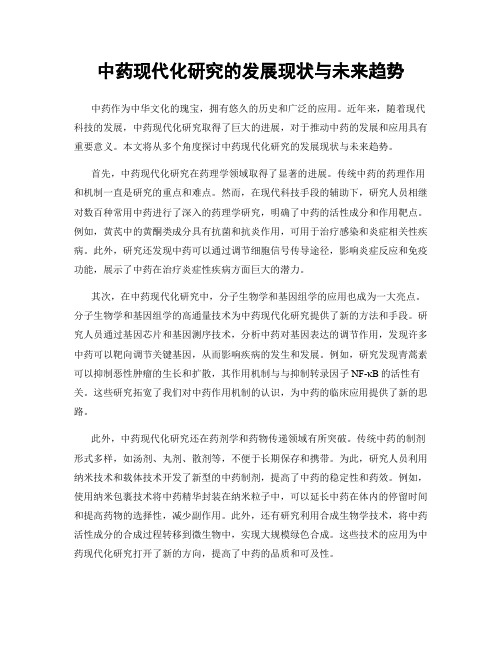
中药现代化研究的发展现状与未来趋势中药作为中华文化的瑰宝,拥有悠久的历史和广泛的应用。
近年来,随着现代科技的发展,中药现代化研究取得了巨大的进展,对于推动中药的发展和应用具有重要意义。
本文将从多个角度探讨中药现代化研究的发展现状与未来趋势。
首先,中药现代化研究在药理学领域取得了显著的进展。
传统中药的药理作用和机制一直是研究的重点和难点。
然而,在现代科技手段的辅助下,研究人员相继对数百种常用中药进行了深入的药理学研究,明确了中药的活性成分和作用靶点。
例如,黄芪中的黄酮类成分具有抗菌和抗炎作用,可用于治疗感染和炎症相关性疾病。
此外,研究还发现中药可以通过调节细胞信号传导途径,影响炎症反应和免疫功能,展示了中药在治疗炎症性疾病方面巨大的潜力。
其次,在中药现代化研究中,分子生物学和基因组学的应用也成为一大亮点。
分子生物学和基因组学的高通量技术为中药现代化研究提供了新的方法和手段。
研究人员通过基因芯片和基因测序技术,分析中药对基因表达的调节作用,发现许多中药可以靶向调节关键基因,从而影响疾病的发生和发展。
例如,研究发现青蒿素可以抑制恶性肿瘤的生长和扩散,其作用机制与与抑制转录因子NF-κB的活性有关。
这些研究拓宽了我们对中药作用机制的认识,为中药的临床应用提供了新的思路。
此外,中药现代化研究还在药剂学和药物传递领域有所突破。
传统中药的制剂形式多样,如汤剂、丸剂、散剂等,不便于长期保存和携带。
为此,研究人员利用纳米技术和载体技术开发了新型的中药制剂,提高了中药的稳定性和药效。
例如,使用纳米包裹技术将中药精华封装在纳米粒子中,可以延长中药在体内的停留时间和提高药物的选择性,减少副作用。
此外,还有研究利用合成生物学技术,将中药活性成分的合成过程转移到微生物中,实现大规模绿色合成。
这些技术的应用为中药现代化研究打开了新的方向,提高了中药的品质和可及性。
综上所述,中药现代化研究在多个领域取得了重要的突破,为中药的发展和应用提供了有力的支持。
中药现代化发展趋势及其面临的挑战

中药现代化发展趋势及其面临的挑战中药作为中国传统医学的瑰宝,对于保障人民健康发挥着重要作用。
然而,近年来随着现代医学的快速发展,中药面临着现代化发展的诸多挑战。
本文将探讨中药现代化发展趋势及其面临的挑战。
一、中药现代化发展趋势:1. 中药研发技术的提升:随着科技的不断进步,中药研发技术逐渐得到提升。
现代科学技术的应用,包括高通量筛选技术、分子生物学和生物工程技术等,为中药的研发提供了强大支持。
这些技术的应用能够提高中药活性成分的提取效率和药效的评价,从而加快中药现代化进程。
2. 中药标准化建设的推进:中药材的质量稳定性一直是中药现代化发展的关键问题。
为了确保中药的质量和疗效,标准化建设变得尤为重要。
通过制定和完善中药的质量标准、生产标准和检测方法,可以提高中药的质量控制水平,并确保中药的安全性和有效性。
3. 模式创新与中西医结合:中药的现代化发展需要进行模式创新。
传统的中药制剂方式在现代医疗环境下未能适应。
因此,探索中医诊疗模式与现代医学相结合的新途径,将中药融入到现代化的治疗方案中,可以更好地发挥中药的疗效。
4. 中药国际化:中药的现代化发展需要拓展国际市场。
中药在国际市场上的影响力有限,部分是由于缺乏国际化的宣传和推广。
因此,通过适应国际市场需求,加强品牌建设和市场营销,推动中药的国际化发展,将有助于中药在全球范围内发挥更大的作用。
二、中药现代化发展面临的挑战:1. 质量与安全问题:中药制剂的质量和安全问题一直是中药现代化发展的重要难题。
中药材的生产环节中存在着农药残留、重金属污染等问题,而中药制剂的质量控制又相对困难。
因此,如何确保中药的质量和安全性,是中药现代化发展面临的重要挑战。
2. 缺乏科学临床验证:中药作为传统的治疗手段,其疗效缺乏科学临床验证。
现代医学注重以循证医学为基础,而中药的疗效往往缺乏临床试验的支持。
因此,如何通过严格的科学实验来验证中药的疗效,是中药现代化发展面临的又一挑战。
中医药的现代化发展与创新路径探索
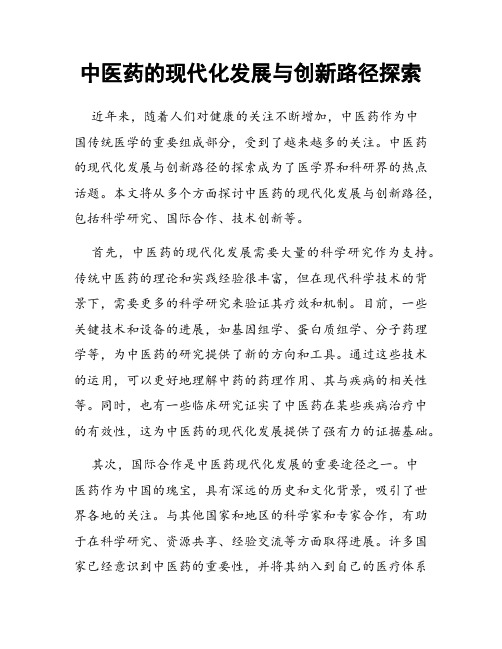
中医药的现代化发展与创新路径探索近年来,随着人们对健康的关注不断增加,中医药作为中国传统医学的重要组成部分,受到了越来越多的关注。
中医药的现代化发展与创新路径的探索成为了医学界和科研界的热点话题。
本文将从多个方面探讨中医药的现代化发展与创新路径,包括科学研究、国际合作、技术创新等。
首先,中医药的现代化发展需要大量的科学研究作为支持。
传统中医药的理论和实践经验很丰富,但在现代科学技术的背景下,需要更多的科学研究来验证其疗效和机制。
目前,一些关键技术和设备的进展,如基因组学、蛋白质组学、分子药理学等,为中医药的研究提供了新的方向和工具。
通过这些技术的运用,可以更好地理解中药的药理作用、其与疾病的相关性等。
同时,也有一些临床研究证实了中医药在某些疾病治疗中的有效性,这为中医药的现代化发展提供了强有力的证据基础。
其次,国际合作是中医药现代化发展的重要途径之一。
中医药作为中国的瑰宝,具有深远的历史和文化背景,吸引了世界各地的关注。
与其他国家和地区的科学家和专家合作,有助于在科学研究、资源共享、经验交流等方面取得进展。
许多国家已经意识到中医药的重要性,并将其纳入到自己的医疗体系和科学研究中。
通过国际合作,可以促进中医药的现代化发展和国际化进程,加速中医药在全球范围内的传播和应用。
此外,技术创新也是中医药现代化发展的关键路径之一。
随着信息技术和生物技术的迅速发展,中医药的研究和应用领域也在不断扩展。
中医药的现代化发展需要借助现代科技手段,比如生物技术、纳米技术、智能化设备等,来加强对中药材的研发、生产和质量控制。
例如,利用基因组学和蛋白质组学技术,可以解析中药材的成分和作用机制,提高其疗效和安全性。
同时,结合智能化设备,如无人化中药煎煮机器人等,可以提高中药制剂的生产效率和一致性。
技术创新的推动将为中医药的现代化发展提供更多的可能性和机遇。
另外,政府的政策支持和资源投入也是中医药现代化发展的重要条件。
在中医药发展的过程中,政府需加大对中医药研究的资金支持,提高科研人员的待遇和福利,鼓励他们进行创新性研究。
医药行业中医药现代化与国际化方案

医药行业中医药现代化与国际化方案第1章中医药现代化发展现状与趋势 (3)1.1 中医药现代化发展概述 (3)1.2 国内外中医药现代化政策与法规 (3)1.3 中医药现代化发展的主要成就与问题 (4)1.4 中医药现代化未来发展趋势 (4)第2章中医药国际化战略布局 (4)2.1 中医药国际化发展现状 (4)2.2 中医药国际市场需求与潜力分析 (5)2.2.1 国际市场需求 (5)2.2.2 市场潜力分析 (5)2.3 中医药国际化战略目标与路径选择 (5)2.3.1 战略目标 (5)2.3.2 路径选择 (5)第3章中医药科技创新与现代化 (5)3.1 中医药科技创新体系构建 (5)3.1.1 政策支持与制度创新 (6)3.1.2 科研机构与人才队伍建设 (6)3.1.3 投资与融资机制 (6)3.2 中药现代化关键技术研发 (6)3.2.1 中药标准化 (6)3.2.2 中药提取与制备技术 (6)3.2.3 中药药效评价与安全性研究 (6)3.3 中医药现代生物技术应用 (6)3.3.1 中药资源保护与可持续利用 (7)3.3.2 中药活性成分筛选与评价 (7)3.3.3 中医药生物工程技术 (7)第4章中药质量控制与标准化 (7)4.1 中药质量控制现状与问题 (7)4.2 中药质量控制关键技术 (7)4.2.1 药材种植与采收技术 (7)4.2.2 加工炮制技术 (7)4.2.3 质量控制指标研究 (8)4.2.4 分析检测技术 (8)4.2.5 指纹图谱技术 (8)4.3 中药标准化体系构建 (8)4.3.1 标准化制定 (8)4.3.2 标准化管理 (8)4.3.3 标准化实施 (8)4.3.4 国际合作与交流 (8)第5章中医药知识产权保护与国际化 (8)5.1 中医药知识产权保护现状与问题 (8)5.1.1 知识产权保护现状 (8)5.1.2 存在的问题 (9)5.2 中医药知识产权保护策略与措施 (9)5.2.1 完善中医药知识产权法律体系 (9)5.2.2 提高中医药知识产权保护意识 (9)5.2.3 加强中医药知识产权审查与执法 (9)5.3 中医药国际化中的知识产权布局 (9)5.3.1 国际市场分析与目标定位 (9)5.3.2 国际知识产权申请与布局 (9)5.3.3 构建国际化中医药知识产权保护体系 (9)第6章中医药国际市场开拓与营销策略 (10)6.1 中医药国际市场分析 (10)6.1.1 国际市场概述 (10)6.1.2 市场规模及增长趋势 (10)6.1.3 市场需求特点 (10)6.1.4 市场竞争态势 (10)6.2 中医药国际市场开拓策略 (10)6.2.1 产品策略 (10)6.2.2 价格策略 (10)6.2.3 渠道策略 (10)6.2.4 品牌策略 (10)6.3 中医药国际营销模式与渠道建设 (11)6.3.1 营销模式创新 (11)6.3.2 渠道建设与管理 (11)6.3.3 营销网络布局 (11)6.3.4 营销团队建设 (11)第7章中医药国际教育与人才培养 (11)7.1 中医药国际教育现状与发展趋势 (11)7.2 中医药国际化人才培养模式 (11)7.3 中医药国际教育合作与交流 (12)第8章中医药国际医疗服务与合作 (12)8.1 中医药国际医疗服务现状与需求 (12)8.1.1 中医药国际医疗服务现状 (12)8.1.2 中医药国际医疗服务需求 (12)8.2 中医药国际医疗合作模式与案例 (13)8.2.1 合作模式 (13)8.2.2 案例分析 (13)8.3 中医药国际医疗服务质量提升策略 (13)8.3.1 建立中医药国际标准体系 (13)8.3.2 加强中医药人才培养 (13)8.3.3 提升中医药科研创新能力 (14)8.3.4 加强中医药国际宣传与推广 (14)8.3.5 深化国际合作与交流 (14)第9章中医药国际法规与政策研究 (14)9.1 国际中医药法规与政策现状 (14)9.1.1 欧洲地区 (14)9.1.2 亚洲地区 (14)9.1.3 北美地区 (14)9.2 我国中医药国际化政策支持体系 (14)9.2.1 政策法规支持 (15)9.2.2 国际合作与交流 (15)9.2.3 中医药人才培养 (15)9.3 中医药国际法规与政策建议 (15)9.3.1 完善中医药国际法规体系 (15)9.3.2 加强中医药国际标准制定 (15)9.3.3 促进国际中医药合作与交流 (15)9.3.4 培育中医药国际市场 (15)9.3.5 加大中医药国际宣传力度 (15)第10章中医药现代化与国际化产业发展 (16)10.1 中医药产业链现代化发展 (16)10.1.1 产业链现状分析 (16)10.1.2 现代化发展策略 (16)10.2 中医药产业国际化布局与战略 (16)10.2.1 国际市场分析 (16)10.2.2 国际化发展战略 (16)10.3 中医药产业协同发展路径与政策建议 (16)10.3.1 协同发展路径 (16)10.3.2 政策建议 (16)第1章中医药现代化发展现状与趋势1.1 中医药现代化发展概述中医药作为我国传统医学,历经数千年的发展,积累了丰富的理论与实践经验。
国际化背景下中医药产业的发展路径分析
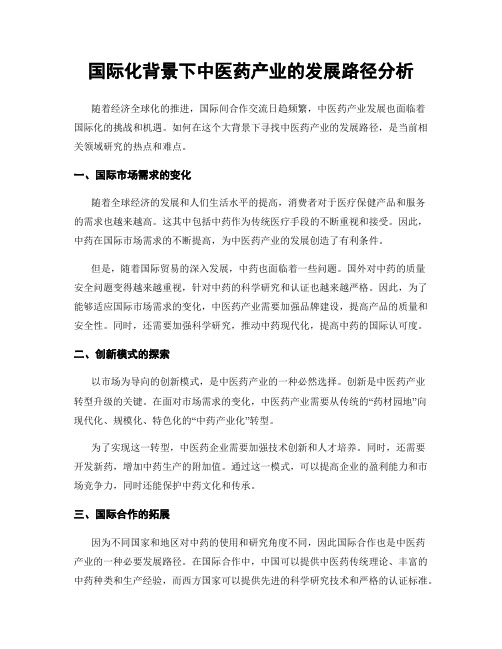
国际化背景下中医药产业的发展路径分析随着经济全球化的推进,国际间合作交流日趋频繁,中医药产业发展也面临着国际化的挑战和机遇。
如何在这个大背景下寻找中医药产业的发展路径,是当前相关领域研究的热点和难点。
一、国际市场需求的变化随着全球经济的发展和人们生活水平的提高,消费者对于医疗保健产品和服务的需求也越来越高。
这其中包括中药作为传统医疗手段的不断重视和接受。
因此,中药在国际市场需求的不断提高,为中医药产业的发展创造了有利条件。
但是,随着国际贸易的深入发展,中药也面临着一些问题。
国外对中药的质量安全问题变得越来越重视,针对中药的科学研究和认证也越来越严格。
因此,为了能够适应国际市场需求的变化,中医药产业需要加强品牌建设,提高产品的质量和安全性。
同时,还需要加强科学研究,推动中药现代化,提高中药的国际认可度。
二、创新模式的探索以市场为导向的创新模式,是中医药产业的一种必然选择。
创新是中医药产业转型升级的关键。
在面对市场需求的变化,中医药产业需要从传统的“药材园地”向现代化、规模化、特色化的“中药产业化”转型。
为了实现这一转型,中医药企业需要加强技术创新和人才培养。
同时,还需要开发新药,增加中药生产的附加值。
通过这一模式,可以提高企业的盈利能力和市场竞争力,同时还能保护中药文化和传承。
三、国际合作的拓展因为不同国家和地区对中药的使用和研究角度不同,因此国际合作也是中医药产业的一种必要发展路径。
在国际合作中,中国可以提供中医药传统理论、丰富的中药种类和生产经验,而西方国家可以提供先进的科学研究技术和严格的认证标准。
因此,中医药产业需要加强与国外企业和研究机构的合作,开展科学研究和开发新药。
同时,还需要注重知识产权保护,提高中医药文化和产业的国际影响力。
综上所述,在国际化大背景下,中医药产业需要面对的挑战和机遇是并存的。
通过创新模式的探索和国际合作的拓展,可以实现中医药产业的转型升级,并为中药走向世界奠定坚实的基础。
中药产业现代化思路探索

国际专利, 符合我国积极参与国际竞争的
要求 。 但 是 如 何做 才 是 真 正 的 中药 现 代 化 ,
伪存真 , 更加完善 , 具科 学性 , 更 更具实用
谢过程及其综合作用 : 研究 中药炮制的深 刻 内涵 : 究中药不 同基源如何统一等等 研 内容。中药现代化一定要将传统的中医药 理论与现代高技术融合在 一起 , 通过发挥 高技术手段 的作用 ,拨 开中药神秘 的面 纱 ,使人们 更清 楚地认识 到 中医 药的精 髓。 在此过程 中使传统的中药理论体系去
药保健品打入 国际市场 , 为中药产业的国 际竞争获得 战略优势 。
12 政府应有 一个对 中药现代化 产业 发 . 展的总体考虑 , 必须要有 一个 中药产业 发
现代化发展的基础工作和正在建设 、 善 完
的法规支持 ;中医药人才 资源 的积累; 丰
展的国家战略, 把中药确 定为国家重点发
2 中药产 业现 代化化 ”
产 业发 展战 略核 心能 力的源 泉
中药产 业的核心 是我 国中药产业所
特 有 的 难 以被 其 他 产 业 和 其 他 国 家 及 地
1 中药现代化发展 战略的对 策思考
11 中 国加 入 WT 后 , 相 当一 部 分 化 学 . O
药物市场作为 自己发挥作用 的舞 台, 极参与 国际竞争。 积
关键词 : 中药现代化 ; 国际化 中药 中图分类 号: . R8 2 文 献标 识码 : A 文章 编号 :63 4 1( 0)1 05— 2 17 — 60 090— 06 0 2
中药现代化研究:从传统药材到新药的发现

中药现代化研究:从传统药材到新药的发现在中国悠久的历史和文化传统中,中药一直扮演着重要的角色。
几千年来,中药被人们广泛使用,治疗各种疾病并保持身体健康。
然而,随着现代医学的发展和科技的进步,人们对中药的认识也在发生变化。
如何将传统中药转化为现代新药,成为了当今中医药领域的关键研究方向之一。
一、中药现代化的背景与意义中药是中国传统医学的重要组成部分,具有独特的药理作用和治疗效果。
然而,由于中药的制备方法繁琐、功效不确定和药理机制复杂,导致中药的临床应用受到了一定的限制。
为了更好地发挥中药的优势,提高中药的疗效和安全性,中药现代化研究成为了迫切需要解决的问题。
中药现代化的研究意义重大。
一方面,中药具有丰富的资源基础和疗效潜力,可以为新药开发提供重要的参考和借鉴。
另一方面,中药现代化可以促进中医药产业的发展,提高中药在国际医药市场的竞争力,为传统中药注入新的活力和生机。
二、中药现代化研究的主要内容1. 中药药物成分的提取与分离中药药物成分的提取与分离是中药现代化研究的重要环节。
传统中药中含有大量的生物活性物质,如碱类、甙类、酚类等,具有多种药理作用。
为了更好地发挥中药的疗效,需要对中药药物成分进行提取与分离,确定其主要活性成分,并探索其药理作用和作用机制。
2. 中药新药的研发与评价中药新药的研发与评价是中药现代化研究的核心内容。
利用现代药理学、药物化学、药代动力学等技术手段,可以对中药药物进行系统研究和评价,筛选出具有良好疗效和安全性的中药新药,并进行临床试验和注册申报,为中药的现代化和国际化打下坚实基础。
3. 中药与西药的结合与创新中药与西药的结合与创新是中药现代化研究的重要方向之一。
中药具有独特的药理作用和药效特点,与西药相结合可以互补优势,提高疗效和减少副作用。
通过中药与西药的结合与创新,可以拓展药物研发的思路和视野,为解决一些难治性疾病提供新的治疗方案。
三、中药现代化研究的挑战与机遇中药现代化研究虽然具有广阔的前景和巨大的潜力,但也面临着诸多挑战。
浅谈中药现代化和国际化的发展现状及对策研究
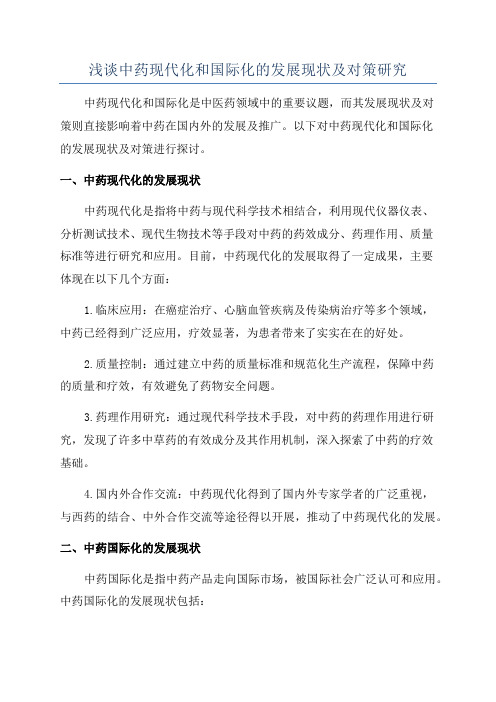
浅谈中药现代化和国际化的发展现状及对策研究中药现代化和国际化是中医药领域中的重要议题,而其发展现状及对策则直接影响着中药在国内外的发展及推广。
以下对中药现代化和国际化的发展现状及对策进行探讨。
一、中药现代化的发展现状中药现代化是指将中药与现代科学技术相结合,利用现代仪器仪表、分析测试技术、现代生物技术等手段对中药的药效成分、药理作用、质量标准等进行研究和应用。
目前,中药现代化的发展取得了一定成果,主要体现在以下几个方面:1.临床应用:在癌症治疗、心脑血管疾病及传染病治疗等多个领域,中药已经得到广泛应用,疗效显著,为患者带来了实实在在的好处。
2.质量控制:通过建立中药的质量标准和规范化生产流程,保障中药的质量和疗效,有效避免了药物安全问题。
3.药理作用研究:通过现代科学技术手段,对中药的药理作用进行研究,发现了许多中草药的有效成分及其作用机制,深入探索了中药的疗效基础。
4.国内外合作交流:中药现代化得到了国内外专家学者的广泛重视,与西药的结合、中外合作交流等途径得以开展,推动了中药现代化的发展。
二、中药国际化的发展现状中药国际化是指中药产品走向国际市场,被国际社会广泛认可和应用。
中药国际化的发展现状包括:1.没有国际质量标准:中药没有统一的国际质量标准,导致中药产品的评价标准和质量认证存在差异,阻碍了中药走向国际市场。
2.缺乏知识产权保护:中药资源的开发和利用缺乏有效的知识产权保护,导致中药产品被侵权复制的现象普遍存在。
3.没有国际认可的临床研究数据:中药的临床研究数据不足,缺乏国际认可的临床试验结果,使得中药在国际市场上的认可度较低。
三、中药现代化和国际化的对策研究要推动中药现代化和国际化的发展,需要制定相应的对策。
以下是一些可能的对策建议:1.加强科研力量:通过加大投入,引进人才,培养科研团队,提高中药现代化研究水平,加强药材、药效成分、药理作用等相关领域的研究。
2.建立质量标准:建立健全中药的质量标准和评价体系,促进中药产品的质量控制和质量标准的国际化。
中药标准化——中药现代化、国际化的需要

国际商贸现代商贸工业2020年第33期46㊀㊀中药标准化——中药现代化、国际化的需要周亚杰1,2,3㊀冯㊀鹏1,2㊀冯㊀敏1,2㊀陈素玲1,2(1.南京中科药业有限公司,江苏南京210008;2.江苏省中药现代化工程技术研究中心,江苏南京210008;3.加拿大魁北克大学蒙特利尔分校,魁北克蒙特利尔H 3C 3P 8)摘㊀要:基于推动中药现代化㊁国际化发展的目的,围绕中药标准化发展问题,做相关的论述,提出加大标准化建设的目的,共享给相关人员参考.从中药标准化的推进角度分析,围绕技术标准和管理制度的制定㊁大数据技术和云计算技术等的应用,规范与扩大中医药使用,促进中药现代化与国际化发展.关键词:中药标准化;中药现代化;国际化中图分类号:F 74㊀㊀㊀㊀㊀文献标识码:A㊀㊀㊀㊀㊀㊀d o i :10.19311/j .c n k i .1672G3198.2020.33.020㊀㊀2020年新冠肺炎疫情的发生,考验着各国医疗能力与水平.从我国的防治经验分析,中西医协同作战,获得重大战略成果.基于此背景,如何有效推动中医药创新和现代化发展,促进中药国际化发展,成为讨论的热点内容.从中药现代化㊁国际化发展道路进程分析,中药标准化为重点.1㊀中药发展现状从发展历程分析,无论是中药理论,还是中药技术,均有着深厚的内涵.随着西医技术的引入,加之现代医疗技术水平的提高,使得中药的地位受到冲击.近年来,我国高度重视中医的发展,加大技术和资金等的投入,同时群众对中医的接受度不断提高,带动着中医的发展.根据公开数据显示,2019年我国中药材产量达到450.5万吨,同期进口数量为6.3万吨,出口数量为12.8万吨.从中药材的字销售情况分析,表观消费量为444.0万吨.从中药材种植情况分析,2018年全国种植5120万亩;2019年为5250万亩.随着中药材产业市场规模不断增长,中药材市场规模已经由2010年的232亿元增长到了2019年的6985亿元.2019年我国中成药市场规模为5463亿元,其提倡天然和绿色以及治末病的养生理念,备受消费者的欢迎,有着较为广阔的发展空间.2020年新冠肺炎疫情的防治实践中,中医药在控制症状和降低轻症转重症的比例㊁提高重症患者治愈率以及降低死亡率等方面,有着突出的表现,发挥重要作用.根据中商产业研究院数据库发布的数据显示,2020年1-2月中国中药材及中式成药出口量为1.8万吨,数量同比增加0.8%;3月出口数量为1.4万吨,数量同比增加29.9%;4月出口数量为1.4万吨,数量同比增加23.6%;5月出口数量为1.2万吨,数量同比增加5.6%;6月出口数量为1.2万吨,数量同比增加19.5%.根据中药发展现状分析,受到中药技术和市场认同度的增加,中药现代化㊁国际化进程将会加速.2㊀中药现代化与国际化发展的挑战2.1㊀中药发展目标实现中药现代化为我国政府的重大决策.根据发展战略和目标分析,主要围绕以下内容开展建设:(1)构筑国家现代化重要创新体系;(2)加速制定与完善现代中药标准与规范;(3)加大技术研究力度,开发具有确切疗效的新产品;(4)形成高竞争力水平的现代化重要产业.推动中药现代化㊁国际化发展,要积极继承与弘扬中药,同时加大技术创新,研发具备高疗效和安全性的重要产品,提高中药的疗效,更好地服务于群众.2.2㊀中药发展面临的挑战从推动中药现代化与国际化发展的角度分析,涉及很多层面,例如药材资源现代化和工艺技术现代化以及质量控制现代化等.其中,实现中药疗效评价现代化,对推动中药现代化系统工程的发展,起到关键和核心作用.若疗效评价存在不合理情况,使得未达到标准和要求的药材流入市场,将会失去消费者基础,难以达到现代化与国际化.例如,部分中成药品呈现假阴性或者假阳性,使得药物疗效不达标,造成 消费者指责㊁业内埋怨 的局面.从持续化发展的角度分析,构建完善的标准体系,提出技术标准和中药临床疗效评价标准等,能够促进中药更好地发展.目前,我国中药疗效评估方面,还存在部分问题,例如上市后药物的临床评估少等.推进中药现代化㊁国际化发展,要围绕生药/饮片质量㊁药材炮制与加工㊁药材调配与制剂工艺技术应用等多个方面,围绕质量㊁技术和安全性等,加大研究和投入力度,搭建创新平台,加大中药标准化研究力度,促进中药产品创新,助力产业持续化发展,实现资源的有效保护与利用.3㊀基于中药现代化与国际化发展背景下的中药标准化建设策略3.1㊀加大中药品标准的制定基于推动中药现代化㊁国际化发展的角度分析,加快标准化建设力度,围绕提升质量㊁保障安全和树立品牌㊁指导合理用药为基本导向和原则,填补当前国家强制性标准的空白,推动管理㊁服务以及技术指南等的创新.目前,中国中药协会已经发布«白芍(毫白芍)产地加工技术规范»以及«无公害三七药材及饮片的农残与重金属及有害元素含量限量»等多项标准,此外有二十余项标准正在立项与编写等阶段.2020年7月20日,中国中药协会发布的«西红花质量等级»标准为行业内首个 质量等级标准 ,将会在10月20日正式实施.目前来说,现有的检测标准,缺少对药材质量的等级区分,对于市场价格的制定,多依据外观和产地确定,由于评价指标缺少客观性,使得市场价格差异较大,给消费者造成极大困扰.对于上述情况和问题,中国中药协会组织多家企业,通过充分调研和实验研究等,基于«中国药典»2015年版,添加西红花特征性成分库番红花素,当作质量指标,同时提出以西红花苷Ⅰ与现代商贸工业2020年第33期47㊀西红花苷Ⅱ含量和,当作等级标准的划分依据,制定«西红花质量等级»团体标准.从推动中药现代化㊁国际化发展的角度来说,要围绕标准空白,加大研究和编制力度,加速中药标准化发展,凝聚发展力量,驱动中药产业持续化发展.3.2㊀加大中药材的标准化制定推动中药现代化与国际化发展,要围绕原材料加大标准化建设力度.以某县为例,贯彻 绿色㊁道地㊁生态㊁有机 发展理念,积极打造2万亩中药材绿色有机标准化药源基地,保证中药材提质增效.从实现中药标准化的角度分析,对于中药材也必须按照标准化种植,种植优质的中药材.目前,中药材种植围绕 产地道地化㊁种源良种化㊁种植生态化㊁生产机械化以及质量溯源信息化 等,加大资金和科技等的投入力度,积极打造绿色标准化种植基地与生态有机药源基地.积极探索现代化种植模式,打造绿色有机标准化药源基地,构建高科技水平㊁机械化装备以及质量全过程控制等的体系,推动中药材标准化,把关中药的质量,创造更多的效益.3.3㊀将中医药纳入国家公共卫生体系2020年新冠肺炎疫情防治中,中医药的表现突出,尤其是提高重症治愈率和降低死亡率等方面.实践中坚持中医药早介入和早使用的原则,达到有效阻断轻症恶化的效果.目前来说,医院系统中中医药救治缺少自己的 阵地 ,需要加大中医医疗队的建设,探索构建具有中医特色的中西医结合救治系统方案.临床实践中坚持中西医结合治疗的原则,积极发挥两者的优势,增强救治的效果.始终坚持以疗效为基本导向的原则,边临床实践边进行研究,面对疫情或者病情时能够快速筛选出治疗药物和方案.促进中药现代化㊁国际化发展,发挥中医药的价值,实现对疫病的有效防治,要积极构建重大传染病防治体制机制,保障中医药能够第一时间参与到公共卫生应急体系,可快速了解疫情并且全程参与.除此之外,完善中医药服务体系;面向市场需求,加大中医药人才队伍的建设.加大中医药基础设施的建设力度,构建完善的基础设施体系,助力中药现代化与国际化发展.总体来说,促进中药现代化㊁国际化㊁标准化发展,要从思想意识层面加大重视度,围绕存在的薄弱点和空白区,加大梳理力度,提出针对性和完善性的措施,助力中医药的发展.3.4㊀贯彻中西医并重理念,促进基层慢病管理近年来,我国高度重视中医药的发展,尤其是中医药在慢病防控领域的推广应用.政府层面相继颁布«中医药发展战略规划纲要(2016-2030年)»以及«关于促进中医药继承创新发展的意见»等相关文件,并且提出 完善覆盖城乡的中医医疗服务网络 以及 促进中西医结合 等各类措施,促进中医药防治慢病的发展.除此之外,积极号召资源力量,围绕 加快中医药循证医学中心建设 以及 加快推进中医药科研和创新 ,积极推动中医药的现代化以及创新发展,切实满足防病治病的需求.从中医药的发展情况来看,拥有深厚的群众基础,尤其是老年群体,在打造中西医并重㊁中医药与西医药相互补充协调发展的健康发展模式时,要面向人民需求,整合各类资源,打造具有中国特色的模式.中医药在慢病管理方面,尤其是心脑血管疾病的预防与治疗,占据着重要地位.随着我国工业化和城镇化以及人口老龄化的不断发展,加之人们的中医养生和运动等理念不断增强,对中医的认可度和接受度不断增加,使得中医在生活方式和生态环境等多个方面的影响日益显现.未来,推动中医现代化和国际化以及标准化发展,要注重加强与规范循证医学数据以及真实世界数据收集与研究,积极发挥政府的导向作用与支持力.从基层医疗机构入手,积极落实和优化基层慢病预防与治疗.3.5㊀加大科技支持力度疫情发生后人们对中医药的认可度快速增加,带来着中医药事业的发展,迎来不错的市场发展机遇.从发展的角度分析,要围绕以下问题加以解决:(1)提供更多具有科学价值的临床疗效证据;(2)充分利用现代化生产方式,支撑和把关中药品的质量和品质;(3)围绕中药材种植与管理角度加大投入力度,种植无公害中药材.坚持以疗效为根本的原则,引入现代化科技手段作为支撑,推动中医现代化和国际化以及标准化发展.充分依托 一带一路 建设资源优势,绘制 中药知识 图,推动中药走向国际,面向沿线国家的民众,共享中医药健康服务.实现中医现代化和国际化发展目标,中药标准化为重点和核心,要拥有严谨的临床试验设计以及科学的循证医学证据,获得国际认可,走出国门,使得中医有指南指导开展临床实践.目前,只有一个进入«欧洲心血管指南»的中药,此重要经过严谨的试验设计,凭借高品质和高质量证据进入,值得借鉴与参考.中药的持续化发展,要守正创新,积极引入现代化科学技术手段,积极进行创新和优化,促进中医药的持续化发展.例如,引入大数据和云计算以及物联网等,从现代科学层面加以规范和扩大中医药的使用,通过信息技术和中药学的融合发展,加大关键技术的研究以及临床疗效的评价等,达成行业内外的共识.4㊀结语综上所述,中药现代化和国际化以及标准化发展,要从多个系统层次入手,加大技术和制度和资金等元素的投入力度,促进中药标准化发展,加速中药现代化和国际化进程.围绕当前中药发展面临的挑战与问题,积极进行优化和完善,创造更多的效益.参考文献[1]焦士勇,曹寅秋,于莉,等.抗击新型冠状病毒肺炎的重点中成药品种专利分析及对我国中药现代化的启示[J ].中国发明与专利,2020,17(06):27G36.[2]赖利平.以中药现代化思想指导的中药学教学改革策略[J ].学周刊,2020,(17):5G6.[3]谭旭明.现代化管理模式提高中药房中药管理的作用分析[J ].中国城乡企业卫生,2020,35(03):225G226.[4]赵茗毅,王启海.人工神经网络在中药现代化研究中的应用[J ].智慧健康,2020,6(05):51G53.[5]肖喜银.中药制剂生产技术现代化的研究[J ].当代化工研究,2020,(03):66G67.[6]戈振凯,赵永恒,蒙静雯,等.中药产业集群发展现状及对人才培养的需求[J ].广西医学,2020,42(02):241G243.[7]陈永,陈艳娟,肖长虹,等.勿以 辨证论治 为中药现代化研究之绊脚石[J ].中医学报,2020,35(01):63G66.[8]尚成英,何霞霞.中药产业应对 一带一路 倡议的知识图谱分析[J ].中医药导报,2020,26(01):5G10.。
中药发展现状及未来趋势
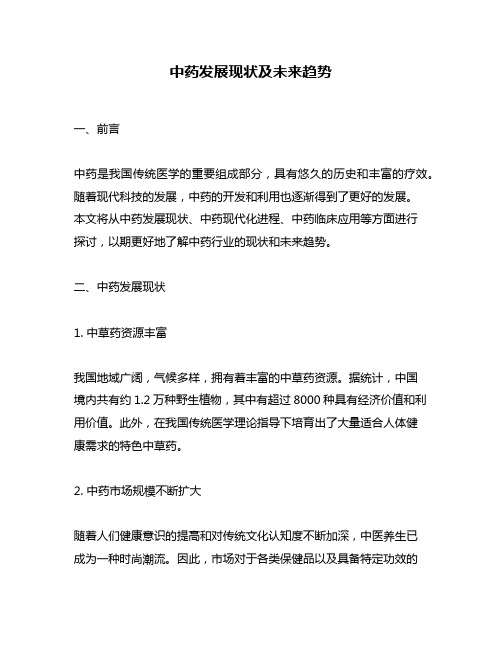
中药发展现状及未来趋势一、前言中药是我国传统医学的重要组成部分,具有悠久的历史和丰富的疗效。
随着现代科技的发展,中药的开发和利用也逐渐得到了更好的发展。
本文将从中药发展现状、中药现代化进程、中药临床应用等方面进行探讨,以期更好地了解中药行业的现状和未来趋势。
二、中药发展现状1. 中草药资源丰富我国地域广阔,气候多样,拥有着丰富的中草药资源。
据统计,中国境内共有约1.2万种野生植物,其中有超过8000种具有经济价值和利用价值。
此外,在我国传统医学理论指导下培育出了大量适合人体健康需求的特色中草药。
2. 中药市场规模不断扩大随着人们健康意识的提高和对传统文化认知度不断加深,中医养生已成为一种时尚潮流。
因此,市场对于各类保健品以及具备特定功效的产品需求也在不断增长。
据有关数据显示,2019年我国中药市场规模达到了约9000亿元人民币,未来还将继续保持较快的增长。
3. 中药现代化技术不断提升在现代科技的支持下,中药现代化技术得到了更好的发展。
传统中草药加工方式已经逐渐被机械化和自动化生产所取代,大大提高了生产效率和产品质量。
此外,中药研究领域也在不断拓展,研究成果得到广泛应用。
三、中药现代化进程1. 中草药标准化生产为了提高中草药产品的质量和安全性,在现代化进程中,对于中草药生产进行标准化管理是非常必要的。
目前已经建立了一套完整的标准体系,并严格执行各项规定。
2. 中成药制剂传统的中医治疗方式常常需要通过一定时间的汤剂煎煮或者调配等方法才能制作出有效成分含量合适、口感良好的治疗方剂。
而现在,随着科技手段不断发展,制剂工艺也变得更加先进,中成药的生产也得到了更好的发展。
3. 中药注射剂中药注射剂是一种新型的中药制剂形式,它具有用量准确、作用迅速、疗效显著等优点。
此外,在注射剂生产过程中,采用了高压灭菌和无菌灌装技术,保证了产品的安全性和有效性。
四、中药临床应用1. 中药治疗心血管疾病目前,心血管疾病已经成为我国慢性非传染性疾病的主要死因之一。
中药行业中的中药现代化与创新发展
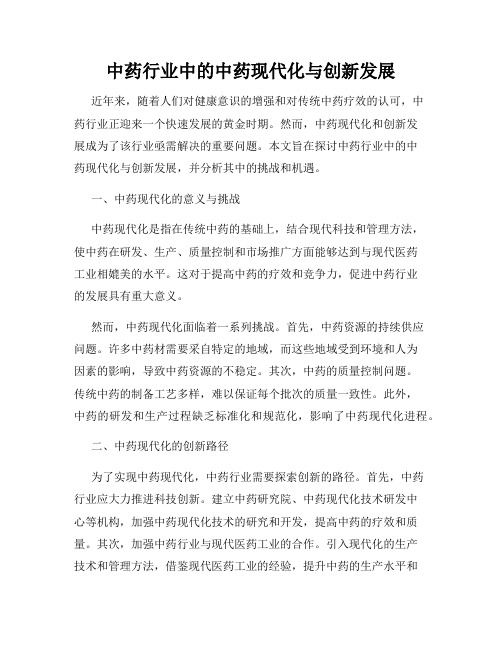
中药行业中的中药现代化与创新发展近年来,随着人们对健康意识的增强和对传统中药疗效的认可,中药行业正迎来一个快速发展的黄金时期。
然而,中药现代化和创新发展成为了该行业亟需解决的重要问题。
本文旨在探讨中药行业中的中药现代化与创新发展,并分析其中的挑战和机遇。
一、中药现代化的意义与挑战中药现代化是指在传统中药的基础上,结合现代科技和管理方法,使中药在研发、生产、质量控制和市场推广方面能够达到与现代医药工业相媲美的水平。
这对于提高中药的疗效和竞争力,促进中药行业的发展具有重大意义。
然而,中药现代化面临着一系列挑战。
首先,中药资源的持续供应问题。
许多中药材需要采自特定的地域,而这些地域受到环境和人为因素的影响,导致中药资源的不稳定。
其次,中药的质量控制问题。
传统中药的制备工艺多样,难以保证每个批次的质量一致性。
此外,中药的研发和生产过程缺乏标准化和规范化,影响了中药现代化进程。
二、中药现代化的创新路径为了实现中药现代化,中药行业需要探索创新的路径。
首先,中药行业应大力推进科技创新。
建立中药研究院、中药现代化技术研发中心等机构,加强中药现代化技术的研究和开发,提高中药的疗效和质量。
其次,加强中药行业与现代医药工业的合作。
引入现代化的生产技术和管理方法,借鉴现代医药工业的经验,提升中药的生产水平和质量控制能力。
此外,在市场推广方面,中药行业应注重品牌建设和市场宣传,增强中药的知名度和竞争力。
三、中药创新发展的机遇与前景虽然中药现代化面临着一系列挑战,但同时也蕴含着巨大的机遇和前景。
首先,中药的国际市场潜力巨大。
中药具有独特的疗效和文化内涵,在全球范围内备受关注。
其次,科技进步为中药现代化提供了重要支持。
随着生物技术、纳米技术等的发展,中药现代化的研究和应用将迎来更多的突破和进展。
此外,政府的支持和投入也为中药行业发展提供了有力保障,为中药现代化创新提供了重要机遇。
综上所述,中药现代化与创新发展是中药行业发展的重要方向。
中药现代化与国际化进程中的挑战与机遇

中药现代化与国际化进程中的挑战与机遇引言中药是我国传统文化的重要组成部分,具有悠久的历史和深厚的文化底蕴。
随着时代的发展和全球化的进程,中药也逐渐走向现代化和国际化,面临着诸多挑战和机遇。
本文将探讨中药现代化与国际化的进程中所面临的挑战与机遇,并提出对策和建议。
一、中药现代化的挑战与机遇1.1 传统与现代之间的融合中药现代化的关键之一是传统与现代之间的融合。
由于中药具有独特的药理特性和治疗效果,传统中药治疗方式和现代药学的发展之间存在一定的矛盾。
如何在保留传统药物疗效的基础上,结合现代科技和医学知识,进行创新和改良,是中药现代化发展中的重要挑战和机遇。
1.2 质量安全与监管问题中药作为一种药物,其质量安全与监管问题一直备受关注。
在中药现代化过程中,如何确保中药的质量安全,成为一个亟待解决的问题。
加强中药质量监管,建立健全的质量控制体系,提高中药质量水平,是中药现代化发展中的重要挑战和机遇。
1.3 国际标准与认可问题随着全球化的发展,中药走向国际市场已成为必然趋势。
然而,由于中药的药理作用和治疗方式与西药存在一定差异,中药在国际市场的认可和接受度较低。
因此,如何与国际标准接轨,提高中药在国际市场的竞争力,是中药国际化发展中的重要挑战和机遇。
二、中药国际化的挑战与机遇2.1 文化差异与传播困难中药作为中国传统文化的重要元素,其文化内涵和历史渊源对于外国人来说可能较难理解。
在中药国际化过程中,如何解决文化差异带来的传播困难,提高中药在国际市场的认知度和接受度,是中药国际化发展中的重要挑战和机遇。
2.2 市场竞争与品牌建设在国际市场竞争激烈的情况下,中药面临着来自西方药物的竞争压力。
如何在国际市场树立中药自身的品牌形象,提高中药的市场竞争力,是中药国际化发展中的重要挑战和机遇。
2.3 法律法规与执法合规在中药国际化过程中,要遵循国际法律法规,保障中药的生产质量和产品安全。
加强中药国际贸易法规的研究和培训,提高中药生产企业的执法合规水平,是中药国际化发展中的重要挑战和机遇。
中药的现代化研究与应用

中药的现代化研究与应用一、中药的历史背景与现状中药作为中国特色的一种传统医学,在中国历史上有着悠久的历史,是我国的瑰宝之一。
经过多年的发展,中药已经成为许多国家和地区的药学宝库中不可或缺的一部分。
尽管中西医结合已经流行数十年,但中药的独特魅力和疗效仍然得到广泛认可。
目前,中药的现代化研究和应用已经成为当今科学技术领域的热门话题,吸引了国内外众多医学专家和学者的关注。
二、中药现代化研究的进展随着现代医学的不断发展,中药也面临着新的挑战和发展机遇,中药现代化研究成为当前医药研究的重要方向。
中药现代化研究主要分为两个方面:一是对中药有效成分进行提取和研究,二是对中药的药效和药理作用进行深入研究。
(a) 中药有效成分的提取和研究中药中的有效成分是中药治疗有效性的关键。
在中药现代化研究中,提取中药中有效成分的纯度非常重要。
当前,针对不同种类的中药,科学家们采用不同的技术手段进行提取和研究。
例如,常用的有超临界流体提取、超声波辅助提取、微波提取等方法。
通过这些方法,提取的中药有效成分纯度可以达到99%以上,为针对某些疾病的治疗提供了更可靠的基础。
(b) 中药药效和药理作用的深入研究中药的药效和药理作用是中药现代化研究的重要方向。
与西药成分相比,中药成分的复杂性和多样性使中药研究的难度更大,但同时也意味着中药具有更广泛的应用前景。
目前,有关中药药效和药理作用的研究主要集中在细胞水平、动物水平和人体试验。
这些研究的结果为中药的应用提供了有力的科学支持。
三、中药现代化研究的应用中药现代化研究的应用正日益广泛,尤其是在医学领域。
以下是中药在现代医学中的一些典型应用:(a) 中药治疗心血管疾病中药在治疗心血管疾病方面具有显著的功效。
例如,在治疗心绞痛、高血压等方面中药配方或药材的应用时已经取得了一定的有效性。
(b) 中药调节免疫系统中药在调节免疫系统方面具有显著的强化作用,对于促进新陈代谢, 减少炎症等都具有良好的效果。
中药现代化的现状及发展趋势
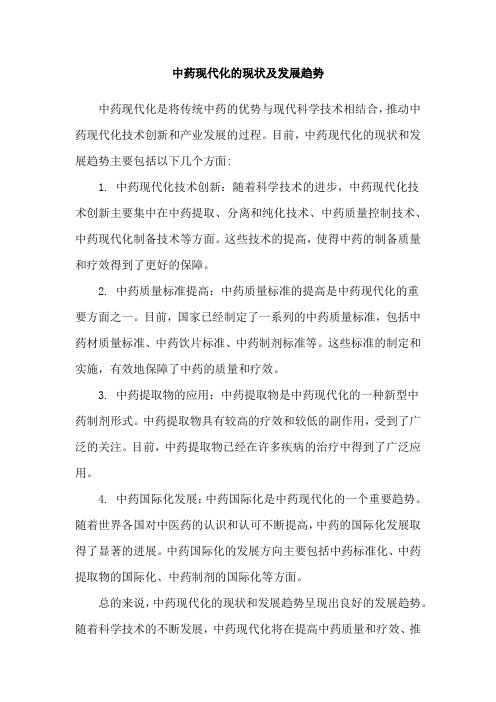
中药现代化的现状及发展趋势
中药现代化是将传统中药的优势与现代科学技术相结合,推动中药现代化技术创新和产业发展的过程。
目前,中药现代化的现状和发展趋势主要包括以下几个方面:
1. 中药现代化技术创新:随着科学技术的进步,中药现代化技
术创新主要集中在中药提取、分离和纯化技术、中药质量控制技术、中药现代化制备技术等方面。
这些技术的提高,使得中药的制备质量和疗效得到了更好的保障。
2. 中药质量标准提高:中药质量标准的提高是中药现代化的重
要方面之一。
目前,国家已经制定了一系列的中药质量标准,包括中药材质量标准、中药饮片标准、中药制剂标准等。
这些标准的制定和实施,有效地保障了中药的质量和疗效。
3. 中药提取物的应用:中药提取物是中药现代化的一种新型中
药制剂形式。
中药提取物具有较高的疗效和较低的副作用,受到了广泛的关注。
目前,中药提取物已经在许多疾病的治疗中得到了广泛应用。
4. 中药国际化发展:中药国际化是中药现代化的一个重要趋势。
随着世界各国对中医药的认识和认可不断提高,中药的国际化发展取得了显著的进展。
中药国际化的发展方向主要包括中药标准化、中药提取物的国际化、中药制剂的国际化等方面。
总的来说,中药现代化的现状和发展趋势呈现出良好的发展趋势。
随着科学技术的不断发展,中药现代化将在提高中药质量和疗效、推
动中医药国际化等方面发挥更加重要的作用。
- 1、下载文档前请自行甄别文档内容的完整性,平台不提供额外的编辑、内容补充、找答案等附加服务。
- 2、"仅部分预览"的文档,不可在线预览部分如存在完整性等问题,可反馈申请退款(可完整预览的文档不适用该条件!)。
- 3、如文档侵犯您的权益,请联系客服反馈,我们会尽快为您处理(人工客服工作时间:9:00-18:30)。
EditorialThe Quest for the Modernization and Internationalization of Traditional ChineseMedicineBoli Zhang a,a Tianjin University ofb ShanghaiInstitutescTraditional Chinese medicine(TCM)is deeply rooted in ancientChinese culture and has been practiced by Chinese people forthousands of years in order to maintain their health andfightagainst disease.This ancient Chinese wisdom has accumulatedfrom the long struggle to cope with various diseases throughhundreds or even thousands of trial-and-error practices.However,due to its empirical character,TCM has long been criticized asbeing deficient in scientific evidence,and is still not widelyaccepted by the mainstream conventional medical system.Thecomplexity of the chemical components of TCM and the clarifica-tion of its mechanisms remain an enormous challenge in the con-version of TCM into an evidence-based medicine.Thanks toincredible progress in biomedical research,TCM has evolved atan astonishing pace in various aspects,as indicated by the2015Nobel Prize awarded to Professor Youyou Tu for her discoveryof artemisinin.In1996,the Chinese government launched the Action Plan forModernized Science and Technology Industry of TCM(hereinafterTCM Modernization Plan),which was aimed at endowing TCMwith ample scientific evidence in terms of its safety,efficacy,quality,modes of action,mechanisms,and so forth.After20yearsof arduous exploration,dramatic progress has been achieved inChinese herbal cultivation,TCM chemistry,TCM pharmacology,processing,quality control,safety,efficacy validation,good manu-facturing practice(GMP)manufacturing,the TCM pharmaceuticalindustry,and more.Since the implementation of good agriculturalpractice(GAP)in Chinese materia medica in2002,over100ing by geometric progression into the hundreds or even thousands,which greatly facilitates the elaboration of TCM quality standards.The paradigm of TCM quality control has shifted from a single-marker model to a holistic approach withfingerprint profiling andmulticomponent assays as the prominent features,in order toenable the evaluation of batch-to-batch consistency and overallquality.TCM globalization has also progressed in an unprece-dented manner,with ninefinished TCM products currently inphase II or phase III clinical trials for US Food and Drug Administra-tion(FDA)registration.Over15quality standards of Chinese herbshave been adopted in the United States Pharmacopeia and75TCMquality monographs have been recorded in the EuropeanPharmacopoeia.The gross value of the industrial output of TCMhas reached a new high of over800billion CNY(about118billionUSD),which is20times greater than the value in1996,the startingyear of the national TCM Modernization Plan.To reflect recent progress and development in TCM researchand to outline future perspectives in thisfield,we have organizedthis special issue dedicated to TCM modernization and internation-alization.Fourteen articles,covering an array of research direc-tions,were invited from prominent scholars and researchers inthefield.Majority of these articles are now published in this issue,the following will be published in the future issues.In this specialissue,Youyou Tu and her colleagues review the past,present,andfuture of artemisinin.The antimalarial mechanism of artemisinin,the challenge tofight against emerging artemisinin-resistantmalaria,and the potential use of artemisinin to treat diseases otherthan malaria,such as cancer and lupus erythematosus,arediscussed in this review.Professor Lan-Juan Li and her colleagues discuss new and increasing evidence of the relation between gut microbiota and host health,which may be associated with the therapeutic activity of TCM formulas.The correlation between TCM and diseases such as chronic liver disease,ulcerative colitis, obesity,and type2diabetes is highlighted,and future research is envisioned,ranging from experimental design to the disclosure of interactions between TCMs and the gut microbiota.A new concept for quality control named the‘‘quality marker”is proposed by Professor Changxiao Liu and his colleagues,and is applied in a number of case studies.The principle of this new concept and approaches to practice it are expounded in depth.In order to elucidate the action mechanism of complex TCM systems,the term chinmedomics is defined by Professor Xijun Wang and his colleagues in the article entitled‘‘Chinmedomics:A powerful approach integrating metabolomics with serum pharmacochem-istry to evaluate the efficacy of traditional Chinese medicine.”Dr.Werner Knoess,the former chairman of the Committee on Herbal Medicinal Products(HMPC)of the European Medicines Agency,describes the detailed requirements for the registration of TCM products in the European Union,which serves as guidance for Chinese enterprises that may be interested in following this process.Safety and quality issues are also emphasized in two papers that focus on summarizing the pros and cons of these two important factors of medicine as a whole.Other aspects of TCM research are covered in the remaining papers,which include: TCM treatment for rheumatoid arthritis;an analysis of Salvia medicinal plants genomes;a DNA molecular marker to differenti-ate between plant species;micro-and nano-formulation to improve TCM bioavailability,tissue distribution,and efficacy;and an electro-acupuncture multicenter randomized controlled clinical trial,which clearly shows the movement of TCM toward becoming an evidence-based medicine.The modernization and internationalization of TCM is a process that will take a considerable length of time;it requires the adoption of new technologies in diverse scientificfields and close cooperation among scholars in multiple disciplines.In the quest to decipher the myths of TCM theory and action mechanisms,all possible resources must be allocated in order to realize this goal, which will benefit the health of all humankind.2 B.Zhang et al./Engineering5(2019)1–2Engineering 2 (2016) xxx–xxxEditorial中药现代化与国际化探索张伯礼a ,杨胜利 b ,果德安 ca Tianjin University of Traditional Chinese Medicine, Tianjin 300193, ChinabShanghai Institutes for Biological Sciences, Chinese Academy of Sciences, Shanghai 200031, China cShanghai Institute of Materia Medica, Chinese Academy of Sciences, Shanghai 201203, China中药深深扎根于中国古代文化,几千年以来,为了保持健康并对抗疾病,中国人民不断进行着中药实践。
